Boyce Upholt at Noema Magazine:
 From a certain point of view, the extraordinary abundance of chickens might be seen as a positive development: Here is a source of protein that is cheaply produced, transportable, happily consumed by a huge number of people across the world. And thanks in part to Peterson’s efforts at improving feed conversion efficiency, chicken has a much slimmer carbon impact than beef, which contributes more than 9% of global emissions.
From a certain point of view, the extraordinary abundance of chickens might be seen as a positive development: Here is a source of protein that is cheaply produced, transportable, happily consumed by a huge number of people across the world. And thanks in part to Peterson’s efforts at improving feed conversion efficiency, chicken has a much slimmer carbon impact than beef, which contributes more than 9% of global emissions.
But the rise of poultry, and of poultry science, has not been great for the chickens themselves. They are now less functional animals than meat-growing machines. So much of a chicken’s energy gets devoted to growing as big as possible as fast as possible that the parts less useful to us humans — lungs and hearts, say — are neglected and wither. Due to underdeveloped immune systems, the birds are dosed with antibiotics. Many full-grown broilers are unable to stand under their weight. Activists and critics have called them “prisoners in their own bodies.”
more here.

 Shortly after Rachel Bespaloff’s suicide in 1949, her friend Jean Wahl published fragments from her final unfinished project. ‘The Instant and Freedom’ condensed themes that occupied the Ukrainian-French philosopher throughout her life: music, rhythm, corporeality, movement and time. One of Bespaloff’s key ideas, ‘the instant’, is less a fragment of duration than a life-changing event, a moment of embodied metamorphosis. In the midst of a noisy world, torn between transience and eternity, the human being listens to the sound of history. Had she completed and published it, ‘The Instant and Freedom’ might have become the masterpiece of an important early existentialist thinker. Instead, her name is hardly mentioned today.
Shortly after Rachel Bespaloff’s suicide in 1949, her friend Jean Wahl published fragments from her final unfinished project. ‘The Instant and Freedom’ condensed themes that occupied the Ukrainian-French philosopher throughout her life: music, rhythm, corporeality, movement and time. One of Bespaloff’s key ideas, ‘the instant’, is less a fragment of duration than a life-changing event, a moment of embodied metamorphosis. In the midst of a noisy world, torn between transience and eternity, the human being listens to the sound of history. Had she completed and published it, ‘The Instant and Freedom’ might have become the masterpiece of an important early existentialist thinker. Instead, her name is hardly mentioned today.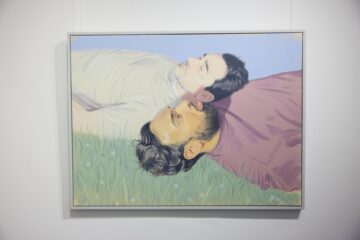 A
A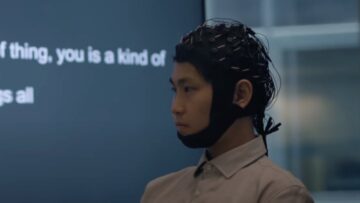 Wearing an electrode-studded cap bristling with wires, a young man silently reads a sentence in his head. Moments later, a Siri-like voice breaks in,
Wearing an electrode-studded cap bristling with wires, a young man silently reads a sentence in his head. Moments later, a Siri-like voice breaks in, 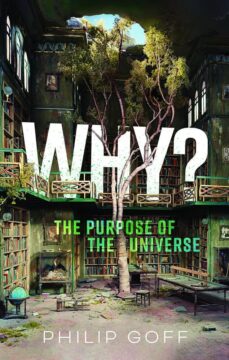 Why is there something rather than nothing? It’s meant to be the great unanswerable question. It’s certainly a poser. It would have been simpler if there’d been nothing: there wouldn’t be anything to explain.
Why is there something rather than nothing? It’s meant to be the great unanswerable question. It’s certainly a poser. It would have been simpler if there’d been nothing: there wouldn’t be anything to explain.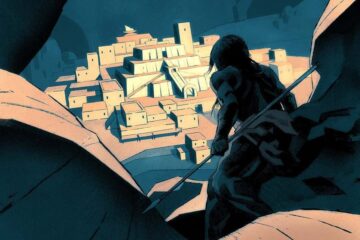 For almost all of human existence, our species has been roaming the planet, living in small groups, hunting and gathering, moving to new areas when the climate was favourable, retreating when it turned nasty. For hundreds of thousands of years, our ancestors used fire to cook and warm themselves. They made tools, shelters, clothing and jewellery – although their possessions were limited to what they could carry. They occasionally came across other hominins, like Neanderthals, and sometimes had sex with them. Across vast swathes of time, history played out, unrecorded.
For almost all of human existence, our species has been roaming the planet, living in small groups, hunting and gathering, moving to new areas when the climate was favourable, retreating when it turned nasty. For hundreds of thousands of years, our ancestors used fire to cook and warm themselves. They made tools, shelters, clothing and jewellery – although their possessions were limited to what they could carry. They occasionally came across other hominins, like Neanderthals, and sometimes had sex with them. Across vast swathes of time, history played out, unrecorded.
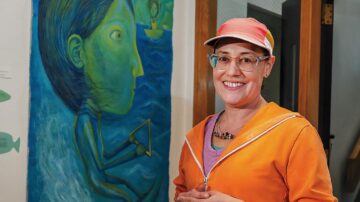 A specialist in epistemology and the philosophy of mind, Siegel has always been fascinated by perception: what and how we see, and the effect that has on what we can know. Her 2010 book, The Contents of Visual Experience, argued that conscious visual perception includes all kinds of complex properties: not just color, shape, light, and motion, but other, richer attributes, too. For instance, it encompasses what kind of thing we see—a tree, a bicycle, a dog?—and causal characteristics, like the property a knife can have while slicing through a piece of bread. Perception can even involve personal identity, Siegel argued: the property of being John Malkovich. The book’s central claim was that being able to visually recognize things, such as one’s own neighborhood, or pine trees, or John Malkovich, can influence how those things look to the person who sees them.
A specialist in epistemology and the philosophy of mind, Siegel has always been fascinated by perception: what and how we see, and the effect that has on what we can know. Her 2010 book, The Contents of Visual Experience, argued that conscious visual perception includes all kinds of complex properties: not just color, shape, light, and motion, but other, richer attributes, too. For instance, it encompasses what kind of thing we see—a tree, a bicycle, a dog?—and causal characteristics, like the property a knife can have while slicing through a piece of bread. Perception can even involve personal identity, Siegel argued: the property of being John Malkovich. The book’s central claim was that being able to visually recognize things, such as one’s own neighborhood, or pine trees, or John Malkovich, can influence how those things look to the person who sees them. Reclusive and disaffected, Ettore Majorana liked to work in the shadows. But after his friend Emilio Segrè dragged him into Enrico Fermi’s elite Roman physics club in the late 1920s, Majorana’s stature in atomic physics quickly grew. His mostly unpublished premonitions were eerily prescient: Among others, he famously intuited the existence of the neutron from prior experiments. And in 1937, he
Reclusive and disaffected, Ettore Majorana liked to work in the shadows. But after his friend Emilio Segrè dragged him into Enrico Fermi’s elite Roman physics club in the late 1920s, Majorana’s stature in atomic physics quickly grew. His mostly unpublished premonitions were eerily prescient: Among others, he famously intuited the existence of the neutron from prior experiments. And in 1937, he  HOW ROMANTIC IS J. M. COETZEE? At first the question, prompted by his eighteenth novel, The Pole, sounds like a joke. The journalist Rian Malan, who visited Coetzee’s office at the University of Cape Town in the early 1990s, reported that the novelist didn’t smoke, drink, eat meat, or, except on very rare occasions, laugh. “It helps to have a piercing gaze,” Coetzee wrote in one of eight essays on Beckett, and his own author photographs show a man who, with his ironed shirts, unvainly swept-back hair, and eyes that would win any no-blinking competition, resembles a semi-retired notary public, or a mob boss who hasn’t got his hands dirty for decades. In his work, too, he offers little in the way of solace or solicitude, presenting a harsh world in parched prose.
HOW ROMANTIC IS J. M. COETZEE? At first the question, prompted by his eighteenth novel, The Pole, sounds like a joke. The journalist Rian Malan, who visited Coetzee’s office at the University of Cape Town in the early 1990s, reported that the novelist didn’t smoke, drink, eat meat, or, except on very rare occasions, laugh. “It helps to have a piercing gaze,” Coetzee wrote in one of eight essays on Beckett, and his own author photographs show a man who, with his ironed shirts, unvainly swept-back hair, and eyes that would win any no-blinking competition, resembles a semi-retired notary public, or a mob boss who hasn’t got his hands dirty for decades. In his work, too, he offers little in the way of solace or solicitude, presenting a harsh world in parched prose. Bella Baxter, the heroine of Poor Things in both the book and the film, often feels like one of those peculiar characters who appear in philosophy. In “Epiphenomenal Qualia,” for example, the Australian analytic philosopher Frank Jackson tells us about Mary, a brilliant scientist who “for whatever reason” has always lived inside a black and white room, learning everything about the world by watching a black and white television. What will happen, Jackson wonders, when we let her out—what knowledge will she gain when she sees the blue sky?
Bella Baxter, the heroine of Poor Things in both the book and the film, often feels like one of those peculiar characters who appear in philosophy. In “Epiphenomenal Qualia,” for example, the Australian analytic philosopher Frank Jackson tells us about Mary, a brilliant scientist who “for whatever reason” has always lived inside a black and white room, learning everything about the world by watching a black and white television. What will happen, Jackson wonders, when we let her out—what knowledge will she gain when she sees the blue sky?
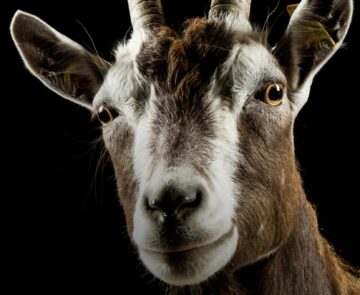 You’d never mistake a goat for a dog, but on an unseasonably warm afternoon in early September, I almost do. I’m in a red-brick barn in northern Germany, trying to keep my sanity amid some of the most unholy noises I’ve ever heard. Sixty Nigerian dwarf goats are taking turns crashing their horns against wooden stalls while unleashing a cacophony of bleats, groans, and retching wails that make it nearly impossible to hold a conversation. Then, amid the chaos, something remarkable happens. One of the animals raises her head over her enclosure and gazes pensively at me, her widely spaced eyes and odd, rectangular pupils seeking to make contact—and perhaps even connection.
You’d never mistake a goat for a dog, but on an unseasonably warm afternoon in early September, I almost do. I’m in a red-brick barn in northern Germany, trying to keep my sanity amid some of the most unholy noises I’ve ever heard. Sixty Nigerian dwarf goats are taking turns crashing their horns against wooden stalls while unleashing a cacophony of bleats, groans, and retching wails that make it nearly impossible to hold a conversation. Then, amid the chaos, something remarkable happens. One of the animals raises her head over her enclosure and gazes pensively at me, her widely spaced eyes and odd, rectangular pupils seeking to make contact—and perhaps even connection. For me, this will always be the year I became a grandparent. It will be the year I spent a lot of precious time with loved ones—whether on the pickleball court or over a rousing game of Settlers of Catan. And 2023 marked the first time I used artificial intelligence for work and other serious reasons, not just to mess around and create parody song lyrics for my friends.
For me, this will always be the year I became a grandparent. It will be the year I spent a lot of precious time with loved ones—whether on the pickleball court or over a rousing game of Settlers of Catan. And 2023 marked the first time I used artificial intelligence for work and other serious reasons, not just to mess around and create parody song lyrics for my friends.